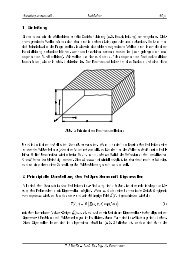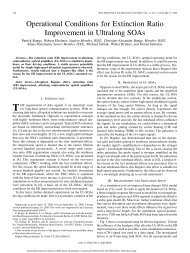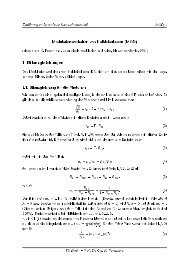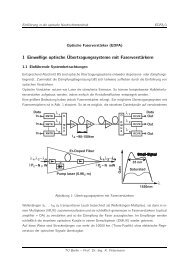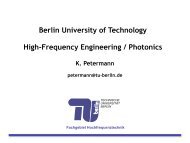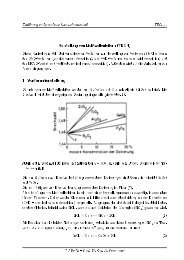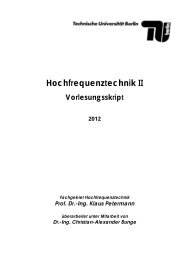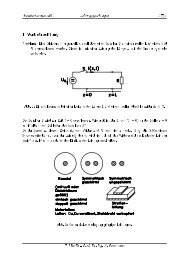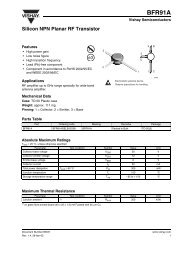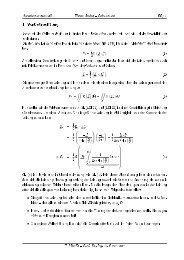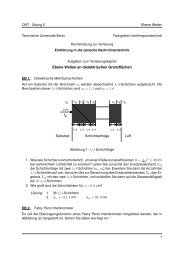All-Optical Wavelength Conversion With Extinction Ratio ...
All-Optical Wavelength Conversion With Extinction Ratio ...
All-Optical Wavelength Conversion With Extinction Ratio ...
Create successful ePaper yourself
Turn your PDF publications into a flip-book with our unique Google optimized e-Paper software.
944 IEEE JOURNAL OF QUANTUM ELECTRONICS, VOL. 46, NO. 6, JUNE 2010<br />
[4] T. Durhuus, B. Mikkelsen, C. Joergensen, S. L. Danielsen, and K.<br />
Stubkjaer, “<strong>All</strong>-optical wavelength conversion by semiconductor optical<br />
amplifiers,” J. Lightw. Technol., vol. 14, no. 6, pp. 942–954, 1996.<br />
[5] C. Joergensen, S. Danielsen, K. Stubkjaer, M. Schilling, K. Daub, P.<br />
Doussiere, F. Pommerau, P. Hansen, H. Poulsen, A. Kloch, M. Vaa, B.<br />
Mikkelsen, E. Lach, G. Laube, W. Idler, and K. Wunstel, “<strong>All</strong>-optical<br />
wavelength conversion at bit rates above 10 Gb/s using semiconductor<br />
optical amplifiers,” IEEE Sel. Topics Quantum Electron., vol. 3, no. 5,<br />
pp. 1168–1180, 1997.<br />
[6] D. Wolfson, A. Kloch, T. Fjelde, C. Janz, B. Dagens, and M. Renaud,<br />
“40 Gb/s all-optical wavelength conversion, regeneration and demultiplexing<br />
in an SOA-based all-active Mach-Zehnder interferometer,”<br />
IEEE Photon. Technol. Lett., vol. 12, no. 3, pp. 332–334, 2000.<br />
[7] G. Contestabile, R. Proietti, N. Calabretta, and E. Ciaramella,<br />
“Cross-gain compression in semiconductor optical amplifiers,” J.<br />
Lightw. Technol., vol. 25, no. 3, pp. 915–921, 2007.<br />
[8] H. Chayet, S. B. Ezra, N. Shachar, S. Tzadok, S. Tsadka, and J.<br />
Leuthold, “Regenerative all-optical wavelength converter based on<br />
semiconductor optical amplifier and sharp frequency response filter,”<br />
in Proc. OFC, 2004, ThS2.<br />
[9] R. J. Manning, X. Yang, R. P. Webb, R. Giller, F. C. Garcia Gunning,<br />
and A. D. Ellis, “The ‘Turbo-Switch’—A novel technique to increase<br />
the high-speed response of SOAs for wavelength conversion,” in Proc.<br />
OFC, 2006, paper OWS8.<br />
[10] J. Leuthold, L. Möller, J. Jaques, S. Cabot, L. Zhang, P. Bernasconi,<br />
M. Cappuzzo, L. Gomez, E. Laskowski, E. Chen, A. Wong-Foy, and<br />
A. Griffin, “160 Gb/s SOA all-optical wavelength converter and assessment<br />
of its regenerative properties,” Electron. Lett., vol. 40, no. 9, pp.<br />
554–555, 2004.<br />
[11] J. Leuthold, W. Freude, G. Boettger, J. Wang, P. Vorreau, and A. Marculescu,<br />
“Trends in the field of all-optical wavelength conversion and<br />
regeneration for communication up to 160 Gb/s,” in Proc. ECOC, 2005,<br />
Tu.3.3.6.<br />
[12] U. Busolt, G. Bramann, H.-J. Wünsche, C. Schmidt, B. Sartorius,<br />
H.-P. Nolting, and T. Rosin, “Two-wave competition for all-optical<br />
signal processing: First experimental verification in ultra-long SOAs,”<br />
in Proc. ECOC, Rimini, 2003, Th3.5.1.<br />
[13] G. Bramann, H.-J. Wünsche, U. Busolt, C. Schmidt, M. Schlak, B. Sartorius,<br />
and H.-P. Nolting, “Two-wave competition in ultralong semiconductor<br />
optical amplifiers,” IEEE J. Quantum Electron., vol. 41, no.<br />
10, pp. 1260–1267, 2005.<br />
[14] P. Runge, R. Elschner, C.-A. Bunge, and K. Petermann, “<strong>Extinction</strong><br />
ratio improvement in ultralong semiconductor optical amplifiers,”<br />
IEEE J. Quantum Electron., vol. 45, no. 6, pp. 578–585, 2009.<br />
[15] A. Bogatov, P. Eliseev, and B. Sverdlov, “Anomalous interaction of<br />
spectral modes in a semiconductor laser,” IEEE J. Quantum Electron.,<br />
vol. 11, no. 7, pp. 510–515, 1975.<br />
[16] A. Uskov, J. Mørk, and J. Mark, “Wave mixing in semiconductor laser<br />
amplifiers due to carrier heating and spectral-hole burning,” IEEE J.<br />
Quantum Electron., vol. 30, no. 8, pp. 1769–1781, 1994.<br />
[17] A. Mecozzi and J. Mørk, “Saturation effects in nondegenerate fourwave<br />
mixing between short optical pulses in semiconductor laser amplifiers,”<br />
IEEE J. Quantum Electron., vol. 3, no. 5, pp. 1190–1207,<br />
1997.<br />
[18] G. Toptchiyski, S. Kindt, K. Petermann, E. Hilliger, S. Diez, and H.<br />
G. Weber, “Time-domain modeling of semiconductor optical amplifiers<br />
for OTDM applications,” J. Lightw. Technol., vol. 17, no. 12, pp.<br />
2577–2583, 1999.<br />
[19] J. Leuthold, M. Mayer, J. Eckner, G. Guekos, H. Melchior, and C.<br />
Zellweger, “Material gain of bulk 1.55 m InGaAsP/InP semiconductor<br />
optical amplifiers approximated by a polynomial model,” J.<br />
Appl. Phys., vol. 87, no. 1, pp. 618–620, 2000.<br />
[20] P. Runge, R. Elschner, and K. Petermann, “Optimising four-wave<br />
mixing in ultralong SOAs,” in Proc. NUSOD ’09, Gwangju, 2009.<br />
[21] P. Runge, R. Elschner, C.-A. Bunge, K. Petermann, M. Schlak, W.<br />
Brinker, and B. Sartorius, “Operational conditions for the extinction<br />
ratio improvement in ultralong SOAs,” IEEE Photon. Technol. Lett.,<br />
vol. 21, no. 2, pp. 106–108, 2009.<br />
[22] P. Runge, K. Petermann, W. Brinker, M. Schlak, and B. Sartorius, “Supercontinuum<br />
generating in ultralong SOAs—Theory and experiment,”<br />
in Proc. ECOC, Vienna, Austria, 2009.<br />
Patrick Runge was born in Berlin, Germany, in 1979. He received the Dipl.-Ing.<br />
degree in computer science from the Technische Universität Berlin, Germany,<br />
in 2005.<br />
From 2005 to 2007 he was with Hymite GmbH, where he was involved in<br />
the design and measurement of optoelectronic packages for optical communication.<br />
In 2007, he returned to the Technische Universität Berlin to pursue the<br />
Ph.D. degree, where he is currently researching the physics and applications of<br />
ultralong semiconductor optical amplifiers.<br />
Christian-Alexander Bunge (S’01–A’02–M’03) was born in Berlin, Germany,<br />
in 1973. He received the Dipl.-Ing. degree in electrical engineering from university<br />
of technology Berlin (TU Berlin) in 1999. Until 2002, he was with TU<br />
Berlin’s photonics group of Prof. Petermann, where he received his Ph.D.<br />
From 2002 to 2004, he was with the Polymer <strong>Optical</strong> Fiber Application<br />
Center (POF-AC) in Nuremberg, where he was responsible for fibre modelling<br />
and short-haul systems design. In 2004, he joined the TU Berlin as senior scientist,<br />
working on high-speed optical transmission systems, studying nonlinear<br />
optics, and modelling of optical components. In 2009, he became professor<br />
at Deutsche Telekom’s university for telecommunication in Leipzig, where<br />
his main research interests are short-haul and access transmission techniques,<br />
multimode glass and polymer-fibre links, and signal processing.<br />
Klaus Petermann (M’76–SM’85–F’09) was born in Mannheim, Germany in<br />
1951. He received the Dipl.-Ing. degree in 1974 and the Dr.-Ing. degree in 1976,<br />
both in electrical engineering from the Technische Universität Braunschweig,<br />
Germany.<br />
From 1974 to 1976, he was a Research Associate at the Institut für Hochfrequenztechnik,<br />
Technische Universität Braunschweig, where he worked on<br />
optical waveguide theory. From 1977 to 1983, he was with AEG-Telefunken,<br />
Forschungsinstitut, Ulm, Germany, where he was engaged in research work<br />
on semiconductor lasers, optical fibers, and optical fiber sensors. In 1983, he<br />
became a Full Professor at the Technische Universität Berlin, Germany. His<br />
current research interests include optical fiber communications and integrated<br />
optics.<br />
Dr. Petermann is a member of the Berlin-Brandenburg Academy of Science.<br />
He is the recipient of the Leibniz Award from the Deutsche Forschungsgemeinschaft<br />
in 1993, and the Distinguished Lecturer Award from the Laser and<br />
Electro-Optics Society within the IEEE in 1999/2000. From 1999 to 2004, he<br />
was an Associate Editor of the IEEE PHOTONICS TECHNOLOGY LETTERS. From<br />
1996 to 2004, he was a member of the board of the Verband Der Elektrotechnik<br />
Elektronik Informationstechnik (VDE). From 2004 to 2006, he was the Vice<br />
President for research at the Technische Universität Berlin.<br />
Authorized licensed use limited to: Technische Universitaet Berlin. Downloaded on March 29,2010 at 05:14:58 EDT from IEEE Xplore. Restrictions apply.



